


 Thunder Bay Press An imprint of Printers Row Publishing Group 10350 Barnes Canyon Road, Suite 100, San Diego, CA 92121 www.thunderbaybooks.com Text and puzzles copyright 2007 Bibelot Limited This edition copyright 2011 BOOKSINABOX All rights reserved. No part of this publication may be reproduced, distributed, or transmitted in any form or by any means, including photocopying, recording, or other electronic or mechanical methods, without the prior written permission of the publisher, except in the case of brief quotations embodied in critical reviews and certain other noncommercial uses permitted by copyright law. Printers Row Publishing Group is a division of Readerlink Distribution Services, LLC. Thunder Bay Press is a registered trademark of Readerlink Distribution Services, LLC. All notations of errors or omissions should be addressed to Thunder Bay Press, Editorial Department, at the above address. All other correspondence (author inquiries, permissions) concerning the content of this book should be addressed to BOOKINABOX, St Chads House, 148 Kings Cross Road, London WC1X 9DH, Publisher: Peter Norton Associate Publisher: Ana Parker Publishing/Editorial Team: April Farr, Kelly Larsen, Kathryn Chipinka, Aaron Guzman Editorial Team: JoAnn Padgett, Melinda Allman eISBN-13: 978-1-62686-081-0 CONTENTS
Thunder Bay Press An imprint of Printers Row Publishing Group 10350 Barnes Canyon Road, Suite 100, San Diego, CA 92121 www.thunderbaybooks.com Text and puzzles copyright 2007 Bibelot Limited This edition copyright 2011 BOOKSINABOX All rights reserved. No part of this publication may be reproduced, distributed, or transmitted in any form or by any means, including photocopying, recording, or other electronic or mechanical methods, without the prior written permission of the publisher, except in the case of brief quotations embodied in critical reviews and certain other noncommercial uses permitted by copyright law. Printers Row Publishing Group is a division of Readerlink Distribution Services, LLC. Thunder Bay Press is a registered trademark of Readerlink Distribution Services, LLC. All notations of errors or omissions should be addressed to Thunder Bay Press, Editorial Department, at the above address. All other correspondence (author inquiries, permissions) concerning the content of this book should be addressed to BOOKINABOX, St Chads House, 148 Kings Cross Road, London WC1X 9DH, Publisher: Peter Norton Associate Publisher: Ana Parker Publishing/Editorial Team: April Farr, Kelly Larsen, Kathryn Chipinka, Aaron Guzman Editorial Team: JoAnn Padgett, Melinda Allman eISBN-13: 978-1-62686-081-0 CONTENTS 
 The World in Miniature T angrams are great fun, and those in this book come with an added twist they are double value! A Brief History No one is quite sure when tangrams were first created, but we do know that they have been around for a very long time.
The World in Miniature T angrams are great fun, and those in this book come with an added twist they are double value! A Brief History No one is quite sure when tangrams were first created, but we do know that they have been around for a very long time.
Indeed, some trace their roots to the placement of furniture! A Ming Dynasty text, BUTTERFLY TABLE PICTURES, contains over a hundred different images, each made up of thirteen tables. Even earlier, in 1194, a book by Huang Bosi comprised a number of diagrams to suggest various ingenious ways of assembling seven banquet tables. These banquet tables were rectangular, and the only geometric rule was that the three small tables were half the length of the largest ones (the length of which was four times their width); the medium-sized tables were midway between the two. Only later were triangles and other shapes introduced, but the resemblance to tangram pieces is clear. In China the game is called QI QIAO BAN, referring to the seven ingenious pieces of the game. Players rearrange the pieces to form set pictures and shapes, and may play alone or against one another, and they may play against the clock.
Tangrams Today Much of the attraction of tangrams lies in their simplicity. That these seven pieces can be rearranged in so many different and pleasing ways is amazing. What at first may appear easy can prove incredibly frustrating, providing hours of fun. But why do we still enjoy tangrams today? Well, they rely not on the rules of any particular language, nor on mathematical expertise. They are puzzles so simple that a child can play and enjoy them for hours on end, yet so complex that even the smartest thinkers may be defeated. They are therefore the perfect, universal puzzle.
Tangrams also exercise our brains, and help particularly to keep aging brains nimble. To find out more, read on Improve Your Brain the Tangram Way There is so much that we still dont know about the human brain, but we do know that it typically contains an amazing ten billion cells and that like other, more familiar, parts of the body, it needs exercise. When we learn something new or try something different, for instance, we forge new connections, or neural pathways, between the brain cells, enabling us to process information in different ways. Visual-Spatial ThinkingMost obviously, tangrams offer a good visual-spatial workout, and help our powers of pattern recognition, a vital tool in understanding the world around us.Improve Your MemoryIf you keep your mind working, your powers of recall should remain just as sharp. Tangrams are an excellent way of exercising the facets of the memory because the more we play, the more we call to mind the methods we used to solve other puzzles. So get started on the tangrams, and stretch yourself while having fun.Think LaterallyAs if all that werent enough, tangrams also provide a lesson in lateral thinking.
Trying out seemingly impossible methods to solve the tangrams will kick-start the whole lateral thinking process, as we begin to think outside the box.Practice Makes PerfectIts generally accepted that high achievers are often those who wont give up. When faced with hurdles they try to work round them. Playing with tangrams teaches us the power of persistence. So learn to apply yourself and if you cant solve a puzzle right away, come back later. Youll be amazed at what your brain is capable of.Double the Fun, Double the WorkNow you know the benefits, its time to play! First, piece together the game board. The rules for the game itself are simple: you must use all seven tangram pieces to play; each must touch at least one other piece and none may overlap; and each piece must be laid flat, though parallelogram pieces may be flipped over.Our tangrams are doubly challenging as each puzzle pair requires you not just to compile the first tangram, but also to transform it into the second in a certain number of moves.
Once youve completed the first part of the puzzle using the first set of tangram pieces, replicate it with the second set of pieces then shuffle these around to solve the second part of the puzzle. If you get stuck, you can refer back to the first set! Puzzles move from easiest Simple Starters to moderate Shape Shifters to the most difficult Puzzling Paradoxes.The solutions at the back show not only how to form each image, but which pieces to move (in grey). It is, of course, possible that you may find other solutions, or may be able to achieve the desired results in fewer moves, and such fluidity is part of the fun and beauty of TANGRAM TEASERS!
 A Little Warm-UpTry your hand at these simple tangram transformations and discover the basic principles behind tangrams.
A Little Warm-UpTry your hand at these simple tangram transformations and discover the basic principles behind tangrams.
ON THE HORIZON
 Next page
Next page

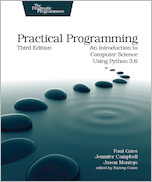
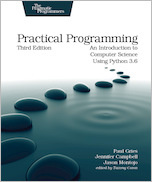
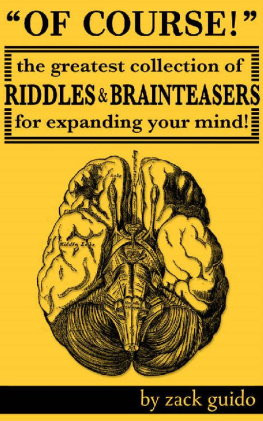
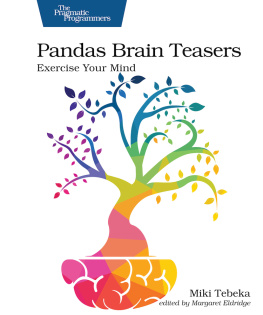
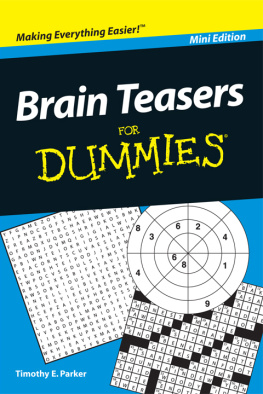
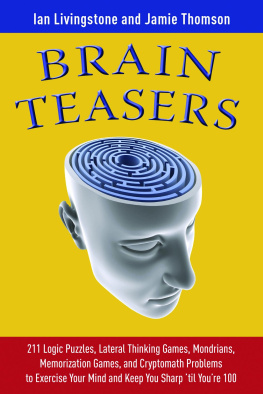

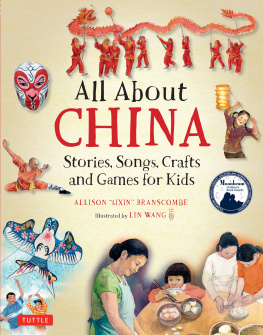
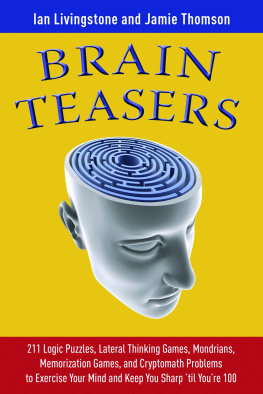
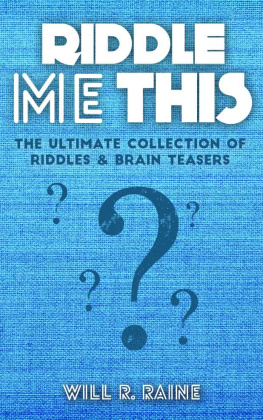


 Thunder Bay Press An imprint of Printers Row Publishing Group 10350 Barnes Canyon Road, Suite 100, San Diego, CA 92121 www.thunderbaybooks.com Text and puzzles copyright 2007 Bibelot Limited This edition copyright 2011 BOOKSINABOX All rights reserved. No part of this publication may be reproduced, distributed, or transmitted in any form or by any means, including photocopying, recording, or other electronic or mechanical methods, without the prior written permission of the publisher, except in the case of brief quotations embodied in critical reviews and certain other noncommercial uses permitted by copyright law. Printers Row Publishing Group is a division of Readerlink Distribution Services, LLC. Thunder Bay Press is a registered trademark of Readerlink Distribution Services, LLC. All notations of errors or omissions should be addressed to Thunder Bay Press, Editorial Department, at the above address. All other correspondence (author inquiries, permissions) concerning the content of this book should be addressed to BOOKINABOX, St Chads House, 148 Kings Cross Road, London WC1X 9DH, Publisher: Peter Norton Associate Publisher: Ana Parker Publishing/Editorial Team: April Farr, Kelly Larsen, Kathryn Chipinka, Aaron Guzman Editorial Team: JoAnn Padgett, Melinda Allman eISBN-13: 978-1-62686-081-0 CONTENTS
Thunder Bay Press An imprint of Printers Row Publishing Group 10350 Barnes Canyon Road, Suite 100, San Diego, CA 92121 www.thunderbaybooks.com Text and puzzles copyright 2007 Bibelot Limited This edition copyright 2011 BOOKSINABOX All rights reserved. No part of this publication may be reproduced, distributed, or transmitted in any form or by any means, including photocopying, recording, or other electronic or mechanical methods, without the prior written permission of the publisher, except in the case of brief quotations embodied in critical reviews and certain other noncommercial uses permitted by copyright law. Printers Row Publishing Group is a division of Readerlink Distribution Services, LLC. Thunder Bay Press is a registered trademark of Readerlink Distribution Services, LLC. All notations of errors or omissions should be addressed to Thunder Bay Press, Editorial Department, at the above address. All other correspondence (author inquiries, permissions) concerning the content of this book should be addressed to BOOKINABOX, St Chads House, 148 Kings Cross Road, London WC1X 9DH, Publisher: Peter Norton Associate Publisher: Ana Parker Publishing/Editorial Team: April Farr, Kelly Larsen, Kathryn Chipinka, Aaron Guzman Editorial Team: JoAnn Padgett, Melinda Allman eISBN-13: 978-1-62686-081-0 CONTENTS 
 The World in Miniature T angrams are great fun, and those in this book come with an added twist they are double value! A Brief History No one is quite sure when tangrams were first created, but we do know that they have been around for a very long time.
The World in Miniature T angrams are great fun, and those in this book come with an added twist they are double value! A Brief History No one is quite sure when tangrams were first created, but we do know that they have been around for a very long time.

